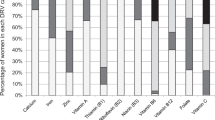Abstract
Objective: To estimate the potential of various industrially produced foods, to serve as a carrier for micronutrient fortification based on the frequency of their consumption in different socio-economic strata; to determine the role of fortified instant noodles as a source of micronutrients; to assess the contribution of plant foods, animal foods and fortified foods to vitamin A intake.
Setting: A survey was conducted in rural South Sulawesi and urban South Kalimantan between November 1996 and January 1997.
Subjects: Households (1500 in South Sulawesi; 2112 in South Kalimantan) were selected randomly by multi-stage cluster sampling. From each household, data were collected from the mother and her youngest child (0–5 y).
Data collection: Mothers were interviewed on various topics, including socio-economic status, food consumption, receipt of high-dose vitamin A capsules, health and nutritional status.
Results: Monosodium glutamate and salt were consumed daily in almost all households in both areas, and consumption was not associated with socio-economic status. Instant noodles were consumed in nearly all households in both areas, but consumption of fortified noodles was related to socio-economic status; it was highest among households of government employees and private investors, and lowest among farmers and share-croppers. Vegetables were the most important source of vitamin A in rural South Sulawesi, while foods of animal origin were the most important source in urban South Kalimantan.
Conclusions: The results support double or triple fortification of salt and/or monosodium glutamate with iodine, vitamin A and/or iron. Efforts to overcome associated technical and logistical difficulties are urgently needed.
Sponsorship: Opportunities for Micronutrient Interventions (OMNI); United States Agency for International Development (USAID).
European Journal of Clinical Nutrition (2000) 54, 822–827
This is a preview of subscription content, access via your institution
Access options
Subscribe to this journal
Receive 12 print issues and online access
$259.00 per year
only $21.58 per issue
Buy this article
- Purchase on Springer Link
- Instant access to full article PDF
Prices may be subject to local taxes which are calculated during checkout
Similar content being viewed by others
Author information
Authors and Affiliations
Contributions
Guarantor: Saskia de Pee.
Contributors: AMB carried out the data analysis and had the main part in writing the manuscript; SdP was involved in designing the survey and in editing and commenting on the manuscript; EM, SH and MS were involved in the design of the study, coordinated the data collection, and wrote the Subjects and methods section of the manuscript; SK, M and MWB had the final responsibility for the survey and gave overall comments on the manuscript.
Corresponding author
Rights and permissions
About this article
Cite this article
Melse-Boonstra, A., de Pee, S., Martini, E. et al. The potential of various foods to serve as a carrier for micronutrient fortification, data from remote areas in Indonesia. Eur J Clin Nutr 54, 822–827 (2000). https://doi.org/10.1038/sj.ejcn.1601094
Received:
Accepted:
Published:
Issue Date:
DOI: https://doi.org/10.1038/sj.ejcn.1601094



